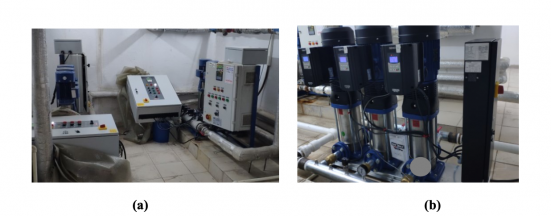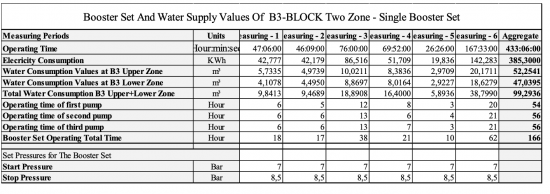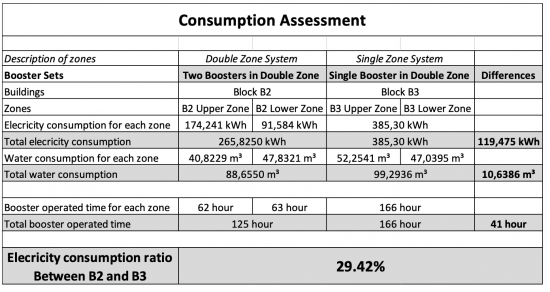
Since ancient times, state rulers have given great importance to big and high rise structures in order to form a perception of wealth and power. Today, high rise buildings have become harboring and commerce centers of large cities with ever-growing populations. The number of high rise buildings has risen as a result of the improvements in building techniques and the gravitation of builders to high rise buildings as a consequence of the interest in such structures. According to the National Fire Protection Association (NFPA), buildings higher that 23 meters (75 feet) are classified as high- rise buildings [1].
High rise buildings bring about a high level of energy consumption due the number of residents they harbor. In this statement, the energy consumption required for pumping clean water supply in high-rise buildings is experimentally examined.
Küçükyalı has stated the importance of the application of efficient boosting systems in high-rise buildings and the pressure zoning for system designs. According to author and engineer Rüknettin Küçükyalı, the aims of pressure zoning are to reduce the static pressure, reduce the upper/lower pressure difference, control the fluid flow [2].
Additionally, he summarized the measures that can be taken in booster systems as follows [2]:
- The system should be divided into vertical pressure levels, using separate boosters for each level.
- Multi-pumps with multi-stage should be used.
- It is recommended that pump booster with variable speed drive (VSD) be used. (Single pumps with VSD in booster use is not suitable as the required pressure is generally the same. For this, it is suitable to use several pumps and choose one of the pumps with variable speed.)
- A pressure reducer should be used at the output of the booster. This prevents pressure fluctuations, and water consumption will be reduced as water with required constant pressure will be sent to the system.
- In these direct pump pressure systems, which are commonly used in America, there three main inefficiencies if the entire building is fed with a single pump:
- - Due to the fluctuating flow, the pump does not operate at the maximum efficiency point. It operates at an inefficient point at partial loads most of the time.
- - Due to the pressure levels in the system, high pressure water is sent to points with low pressure requirement. The pressure energy goes to waste in pressure reducers or taps.
- - Engine efficiency also gets reduced significantly at partial loads.
When this experimental study and its results are considered, it is seen that Küçükyalı’s recommendations are supported.
Methods
In the study, the differences between the method of dividing the clean water supply system of the building into zones and single zone systems in clean water supply applications have been examined.
The study was carried out in two blocks of identical buildings on the same site. These residential building block have the same number of stories, flats and similar number of residents.
Both buildings blocks have stories and 62 flats. In the study, the block names are referred to as B2 and B3, as they are named in the site. (Image 1).

In the building design, the pressurization of clean water is provided by booster sets. The city water feeds two water tanks of 25 cubic meters (m3), in total 50 m3 in each building on the second floor. In both buildings, the system is divided in two zones, upper and lower zones. The pump systems that pressurize each zone is designed separately. The lower zone supplies water from the first to the sixth floors and the upper zone from seventh to the 14th floors. This is what the clean water system design looks like in blocks B2 and B3. (Image 2)
Block B2’s clean water system type is a two-zone system. The building has two zones, each fed with a separate booster. In the lower zone, a constant 6 bar pressure is provided with two 200-liter pressure vessel tanks. In the upper zone, a constant 10 bar pressure is provided with two 300-liter pressure vessel tanks. Booster information of the lower zone is shown in Table 1, the upper zone in Image 2.

Block B3 clean water system type is a double zone system. The building has two zones, fed with one booster. Two 300-liter pressure vessel tanks that provide a constant pressure of 10 bar are used in the system. (Image 2).

In both buildings, boosters of the same brand were used. The boosters used stainless steel, vertical multi-stage centrifugal pumps. A frequency converter was used to run the boosters in both buildings.
All boosters have three pumps. (Image 3).

The water consumption figures were taken from the water meters in the buildings and the electricity consumption from the electricity meters attached to the boosters. The measuring period lasted about three weeks and data readings were done three times a week on average. With readings through fixed periods, figures from both buildings are examined. The water consumption in the buildings are measured and the energy consumption of the boosters are evaluated. Thus, the most efficient method for both buildings are determined.



Results
Following the measurements and readings, the consumption differences between the two buildings are seen clearly. (Table 5).
As a first assessment, when the operation durations of the booster sets are considered, 41 hours of extra operation throughout the 433-hour experiment are seen clearly. Although the lower and the upper pressure set values, the pressure vessel tank pressures and volumes are all equal, the booster operating in the single zone worked 41 more hours for water supply.

When the differences between the total energy consumptions are considered, it shows that the boosting in the single zone required 119,475 kilowatt hours (kWh) more energy. Even though the buildings are identical and have similar occupancy rates, a difference of 10, 6386 m3 water consumption was measured. The water consumption in the single zone building is 10, 6386 m3 more. It is assumed that the electricity consumption was not affected by this difference. Although the overall water consumption of the residents in Block B3 is higher, when the two buildings are compared by unit, it is still clearly seen that the single zone system consumed more energy than the double-zone system. Table 2,3 and 4 can be seen in detail.
The main reason of this high consumption is that in the single zone system, the boosters operate at a further distance from their best efficiency point (BEP). Additionally, the pressure reducing equipment used to protect the individual water supply systems of the flats on the first to sixth floor caused the energy to go to waste.
System losses in both buildings are assumed equal as both building have the same water supply system.

When the energy consumptions are compared to the water consumptions, the total energy consumption ratio (TECR) was calculated independently from the total water consumption and the difference in between was calculated to be %29,42 higher. The single zone booster in Block B3 consumed %29,42 more energy than the double zone system.
Discussion
As seen in the experimental study, it has been certain that water pressurization method with divided zoning in high-rise buildings definitely consumes less energy in supplying water, compared to single zone systems.
However, building height is also a factor in dividing the building into zones. This study has shown that an energy saving rate of 30% has been reached in a 14-story building. It may not prove as effective in buildings with fewer stories than 14 but more than 2 zones may be required for energy saving in buildings with more stories.
Acknowledgement
MAS-DAF Mak. San. A.Ş. has provided financial aid for the equipment used in the study.
References
1. NFPA 20. 2019 Edition. NFPA 20 Standard for the Installation of Stationary Pumps for Fire Protection.
2. KÜÇÜKYALI. R. 2003. Yüksek Bloklarda Tesisat. VI. Ulusal Tesisat Mühendisliği Kongresi ve Sergisi. 328-2

